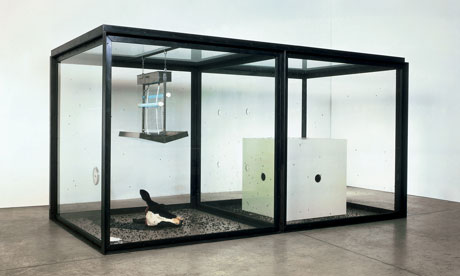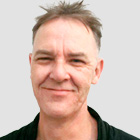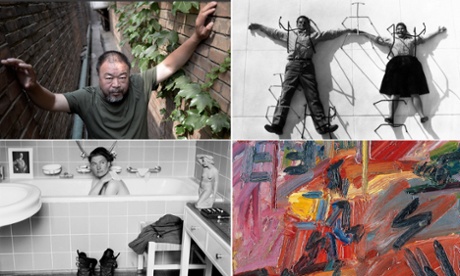Loitering behind the counter of Damien Hirst's Pharmacy, the Tate-owned 1992 room-sized installation that looks remarkably like an upmarket chemist's shop, I was interrupted by a gallery assistant. She stuck her head around the corner and then was gone. Maybe she wanted to buy some suppositories, but was too shy to ask.
I only came in here myself because I had a headache, after looking at all the eye-test dot paintings that punctuate Hirst's Tate Modern survey show, and catching the whiff from Crematorium, Hirst's 1996 ashtray – huge as a hot tub – filled with shovel-loads of old fag-butts and ash, drug-taking paraphernalia, sweet wrappers and swizzle sticks. I had also got down on my knees to sniff through one of the vents set in the glass walls of his A Thousand Years (1990), trying to determine whether it is a real rotting cow's head in there, lying in its pool of congealed blood. I got a face-full of ammoniac air, the smell of all those flies buzzing around, and the corpses piling up in the insecto-cutor where they are being zapped.
One wants to write a straightforward review of Hirst's work, but it is almost impossible. What would it be like, I wonder, for someone with no knowledge of his art, let alone his global reputation, to come along and review this show? What would they see? So much has already been said about Hirst, including a great deal by me. How can we see it fresh?
Tate curator Ann Gallagher has done her best to strip away the excess and repetition of Hirst's art, but it won't go away. It's what he does. The exhibition opens with works from his student years, the late 1980s. A row of pots and pans hangs on the wall, as in a kitchen, their undersides painted in jolly colours. An empty torso-sized MDF-and-laminate kitchen cabinet sits beside his first homespun spot painting, painted on board, which jostles with wonky, dribbly ovoids. Then come the first medicine cabinets, with their empty boxes and jars of pharmaceuticals. The first time I saw these I must have been wandering around with a clipboard, marking them as an external examiner on the Goldsmiths Fine Art degree course. This was 1989, the year after Hirst had curated his famous Freeze exhibition, and already he and his fellow students, and Goldsmiths itself, were famous.
Synthesising the kind of conceptualism-lite, post-pop appropriation and visual gags that many students (and not just at Goldsmiths) were working through at the time, Hirst was also assimilating his influences. These included Kurt Schwitters' collages, minimalism, Bruce Nauman, Jeff Koons's early Hoovers in their dust-free display cabinets, Jannis Kounellis (whose rotting ox carcasses, hung from rods, had been on stomach-churning display though a hot Barcelona summer in 1989) and Francis Bacon. The shadow of American artist Paul Thek was probably in there, too. Thek once decorated a wax arm with butterfly wings, as well as making boxes which housed what looked like raw meat. Like Hirst, Thek also conflated the plight of the body with religious iconography. Thek's career went off the rails and he died from Aids in 1988, the same year Hirst curated Freeze.
With its cow's head and flies, A Thousand Years comes not far into Tate Modern's show, Hirst's first in a British museum. Made the year after he left college, this double-vitrine was first shown in the warehouse group show Gambler, in south London. A Thousand Years is still extremely powerful, and still surprising. Clean and dirty, full of life and death, formally shocking and rich, it has an air of maturity and finality. In a recent interview for the exhibition catalogue, Hirst tells Tate director Nicholas Serota that it is still possibly the most exciting thing he has ever made. Hirst recalls that Lucian Freud said to him, about this work, that "I think you started with the final act, my dear."
Little else Hirst has made is comparable, except perhaps the large, sealed double vitrine from the following year, containing a desk, chair, ashtray and packet of cigarettes (The Acquired Inability to Escape), but even this has the feel of an extrapolation rather than a development. Hirst's shark, The Physical Impossibility of Death in the Mind of Someone Living, from 1991, seems to have shrunk, and here looks more like a specimen than an open-jawed threat. A recent second version is even smaller in its black-framed aquarium; it looks like a tame dogfish, and I can imagine a Ming vase filled with lilies parked on top of its glossy black tank in some collector's home.
There's an element of fun in earlier Hirst: the Sigmar Polke-inspired string of sausages in a formaldehyde-filled frame; the ping-pong ball floating on the updraft of a hairdryer angled to the ceiling. When he repeats this last trick some years later with an airborne beach ball, the idea has lost its lightness. And what, in theory, could be lighter than standing among swooping exotic butterflies in Hirst's 1991 installation In and Out of Love, the creatures hatching from pupae stuck to canvases and floating about the room, living and dying in the space? In reality, it's macabre. Some of their fellows are mired in the thick, gloopy monochromes on the walls of the room next door, which evidences the aftermath of the original show's opening party.
The rest is variation and repetition. Production, in other words: the business of being an artist, and art as business. Hirst's later work might be taken as a critique of the very market that supports him, and the people who buy his work – but I somehow doubt it. Flies begat butterflies, which begat more butterflies. Medicine cabinets begat a whole pharmacy, with endless little pills arranged on shelves. Cabinets begat cabinets, MDF and laminate being replaced by gold-plated steel, nickel and brass. You could stick anything in these cabinets of curiosities and vitrines: medical speculums, nasty operating theatre tools, row after row of man-made diamonds, sheep, cows, Havana cigars – now, why not a human corpse? (Go on, you know you want to.)
This exhibition charts a great descent in Hirst's art, one that mirrors the ascent of his bankability and the creation of ever more decadent and overblown artefacts. I have enjoyed some things – if enjoy is the right word for paintings covered in a crust of dead flies (one of which is here), but the returns have diminished with almost every show. Hirst may well think he is giving us what we deserve: an art of spectacle and the tokens of spectacular wealth. The show's last rooms are full of such things, among them a Carrara marble angel, whose exposed guts and skull are sculpted as tenderly as the feathers on her wings; a white-on-white spot painting whose edges are anointed with gold leaf; a pure white dove caught in flight in a limpid tank of formaldehyde.
The cloying ostentation of these rooms is surely deliberate, but does not make one want to linger. Lots of artists have made works with expensive materials but very few flaunt it the way Damien does. His later work might want to be an attack on the puritanism of a certain sort of highbrow taste, or it might be pandering to the vulgarity of super-rich collectors, or to the perversity of the art market and the place he has come to occupy in it. Maybe he wants it every way he can. Down in the darkened Turbine Hall, his diamond-encrusted platinum skull is displayed in a specially constructed black-box room. The theatricality of this is nauseating – or would be, if it weren't so silly and contrived.
Others have already weighed in with spite, gall and a fury quite out of proportion to the fact that Hirst is only an artist. There are some who look forward to his downfall. In 1991, reviewing In and Out of Love, I wrote that Hirst's work had enormous spirit and great originality, and that I was glad he was around. By 2009 I was writing that his recent paintings were "momento mori for a reputation" (the hapless paintings Hirst showed at the Wallace Collection that year have thankfully been passed over here). My problem with Hirst is not the money (Picasso made lots, and nobody cares), nor the vulgarity he has opted for, but his capitulation as an artist. He could have been so much better. It is an enormous disappointment.
• This article was amended on 24 April 2012. References to Formica, which is a trademark, have been changed to laminate.











